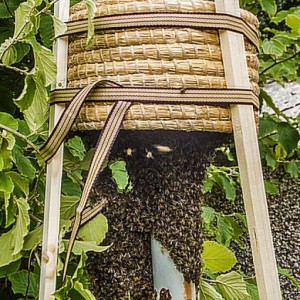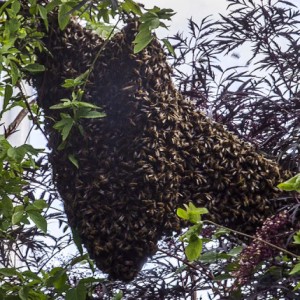The Swarm.
Today was going to be a quiet relaxing day: packing my gear for the race, last minute adjustments to the trike – you know the sort of thing – but before starting, I popped down the garden to the bees as I thought they would need feeding. As I approached there was this sort of roaring noise and, once I’d ascertained that there was no motorcycle being driven past at reckless speed, I became aware that I was in the middle of a cloud of bees. At times like these, it is important not to panic and check that you have a comb about your person; a swarm of bees is quite benign but the odd individual might panic if trapped in your hair so a quiet retreat was executed. Mrs TD, with a complete lack of tact and an unerring aim at the jugular enquired if this had happened due to my negligence.
It is normal for a swarm to dangle from a low, slender stem that bends alarmingly under its weight; this is convenient for the beekeeper as he merely has to place a receptacle underneath (a skep is the right container for the job but, often, a cardboard box is an adequate or even superior substitute) and give the branch a good firm shake whereupon the bees fall neatly into the container. They could so easily have settled on the adjacent, very rigid, clothes pole, in fact there were a few bees settled there as I watched. Unfortunately, the equipment needed was all in the most sensible place imaginable, at the apiary four miles down the road - so I went off to retrieve it.
On my return, I set up a hive to receive the swarm; there was no hurry, they were unlikely to move any time soon, they were probably planning on spending the night there. With everything ready, I executed the manoeuvre detailed above and then poured the skepful of bees into the top of the hive; there is a more elegant method that is useful for impressing non-beekeepers but, in practice, is not really any more efficient. It was at this stage that herself commented - from a safe distance – that the few bees on the clothes post seemed to be increasing in number; I, on the other hand, noticed that the bees were pouring out of the front door of the hive as quickly as I was pouring them in at the top. The realisation that the those original few bees included the only important member of the community slowly dawned; the queen had never been in the main cluster but was sitting on the top of the post laughing at me. See the first extra.
The technique now required was a little different. A swarm has two preferences, the first is to find a dark place to rest while the second is to climb up, hence you need to use a skep rather than a cardboard box and find some way of supporting it over the cluster. There then follows a period of a few hours gently wafting smoke over the little darlings to coax them up. Fortunately, bees tend to swarm on nice warm sunny days at around 2 pm, not at 10 am on days when thunder storms are forecast, so collecting a swarm in this way is usually a pleasant way of spending a relaxing afternoon. These bees fairly scampered up into the skep (second extra) and within 15 minutes I was duly pouring them back into the top of the hive – and they were duly pouring out of the front door and re-convening on the top of the post. It is impossible to catch every single bee out of the twenty thousand or more in a swarm, so I was left to assume that the queen had never strayed from her vantage point and was still sitting there laughing at me.
I had just finished re-assembling my tripod mounted skep when the little darlings started taking to the air. With enough fuel on board to travel a couple of miles across country, that was likely to be the last I saw of them unless they landed in somebody’s garden and that somebody phoned the council for me to come and collect them though, these days, it seems that the council can’t afford to phone me for my free service. It was then that a minor miracle occurred, having risen fifty feet up into the air, they returned to earth and settled on our rowan tree on a nice bendy stem that sagged under their weight (third extra) so I went indoors and had some lunch and tried to let my frustrations calm down a little.
Thirty minutes later and suitably refreshed in mind and body, I returned to the fray armed with a two metre stick with a nail banged at right angles into its end, and a large cardboard box. (Amazon are a very cheap supplier of swarm collection boxes which, when worn out, make good smoker fuel.) With the stick I hooked the branch down to within reach and grabbed hold of it with one hand and the box with the other. The next stage was to bring the box and swarm into conjunction so that the bulk of the bees were inside the box; a firm shake deposited that bulk into the box and I was able to pour the bees into the top of the hive again and, since they seemed contend to stay there this time, I put a lid on. Most of the extended right arm of the cluster in the picture remained in situ and now needed attention but, first, I put a board against the entrance to the hive. A repeat performance with the stick and box secured the remainder of the bees which I poured onto the board at the hive entrance and had the pleasure of watching the bees march purposefully in through their front door, a sure sign that the queen was actually in residence (fourth extra). I resisted the temptation of sticking a little union flag (last used when making sand castles with Jnr) on the lid.
Jnr wanted to borrow the car to support his football team in the preliminary stages of their attempt at winning a minor European cup; he shouldn’t have bothered, they played abysmally - after the fashion of England being beaten by Iceland in a major European cup competition. He wasn’t happy when he returned after dark, but there was still a price to pay. I needed his help to transfer the new colony to the apiary, an easy task in daylight but not so easy at night. That was just before the thunderstorm started.
A swarm has a lot of work to do: it needs to build a lot of honey comb to start raising brood and it needs to do it quickly so that it goes into the winter with plenty of bees and plenty of food stored. To achieve that, it needs feeding – particularly as there seems to be a dearth of nectar this year. In the natural state, they just wouldn’t survive but this time they’ll have to manage by themselves until Tuesday as I will be away first thing tomorrow and will not return until Monday evening. Then they can have all the food they want. In the last year, I have bought nearly a hundred kilos of sugar for them at a cost of over £50 and it remains doubtful if there will be a honey crop. Is it worth the time and expense? Well, I now have four good colonies whereas, a year ago, I had one good colony, one crabby and lazy one and one that was not expected to survive more than a few weeks. Each one has a market value of £250 plus the cost of the housing and, more importantly, I have had a lot of pleasure from the venture.




Comments
Sign in or get an account to comment.


